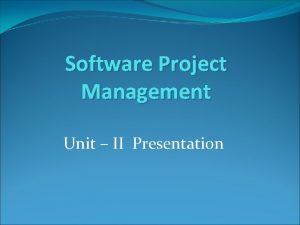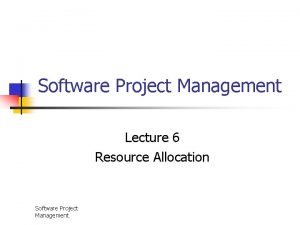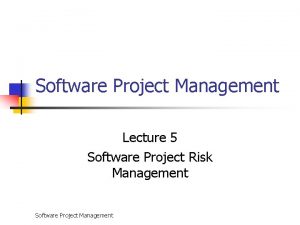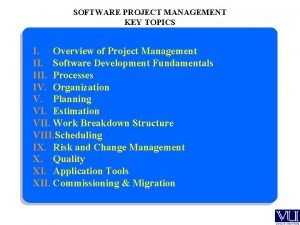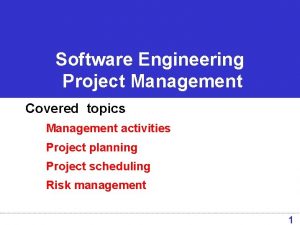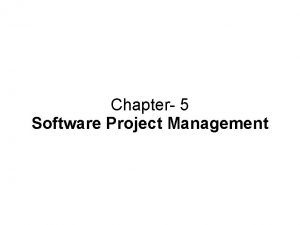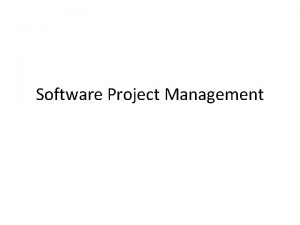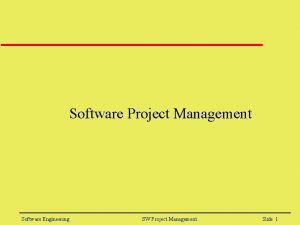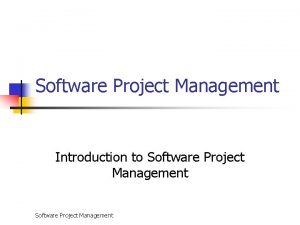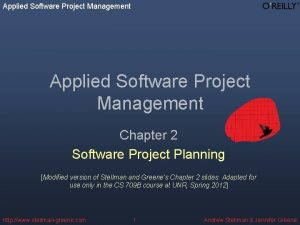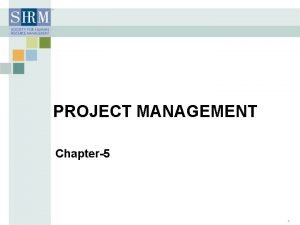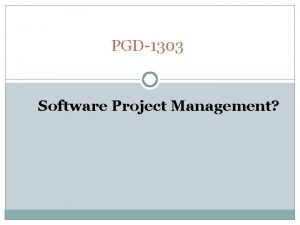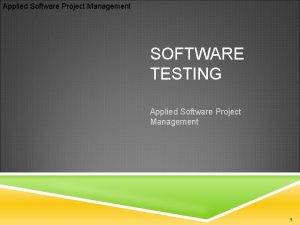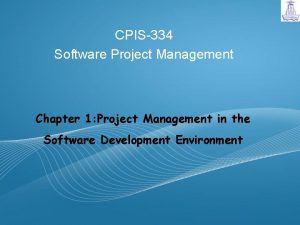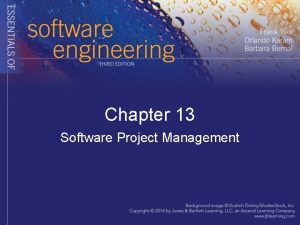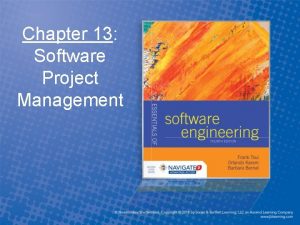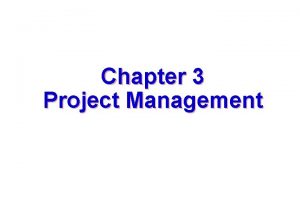Software Project Management 4 th Edition Chapter 3


























- Slides: 26

Software Project Management 4 th Edition Chapter 3 Programme management and project evaluation 1 ©The Mc. Graw-Hill Companies, 2005

Main topics to be covered • Programme management • Benefits management • Project evaluation – Cost benefit analysis – Cash flow forecasting • Project risk evaluation 2 ©The Mc. Graw-Hill Companies, 2005

Programme management • One definition: ‘a group of projects that are managed in a co-ordinated way to gain benefits that would not be possible were the projects to be managed independently’ Ferns 3 ©The Mc. Graw-Hill Companies, 2005

Programmes may be • • Strategic Business cycle programmes Infrastructure programmes Research and development programmes • Innovative partnerships 4 ©The Mc. Graw-Hill Companies, 2005

Programme managers versus project managers Programme manager – Many simultaneous projects – Personal relationship with skilled resources – Optimization of resource use – Projects tend to be seen as similar Project manager – One project at a time – Impersonal relationship with resources – Minimization of demand for resources – Projects tend to be seen as unique 5 ©The Mc. Graw-Hill Companies, 2005

Projects sharing resources 6 ©The Mc. Graw-Hill Companies, 2005

Strategic programmes • Based on OGC approach • Initial planning document is the Programme Mandate describing – The new services/capabilities that the programme should deliver – How an organization will be improved – Fit with existing organizational goals • A programme director appointed a champion for the scheme 7 ©The Mc. Graw-Hill Companies, 2005

Next stages/documents • The programme brief – equivalent of a feasibility study: emphasis on costs and benefits • The vision statement – explains the new capability that the organization will have • The blueprint – explains the changes to be made to obtain the new capability 8 ©The Mc. Graw-Hill Companies, 2005

Benefits management developers build users organization use for the application benefits to deliver • Providing an organization with a capability does not guarantee that this will provide benefits envisaged – need for benefits management • This has to be outside the project – project will have been completed • Therefore done at programme level 9 ©The Mc. Graw-Hill Companies, 2005

Benefits management To carry this out, you must: • Define expected benefits • Analyse balance between costs and benefits • Plan how benefits will be achieved • Allocate responsibilities for their achievement • Monitor achievement of benefits 10 ©The Mc. Graw-Hill Companies, 2005

Benefits These might include: • Mandatory requirement • Improved quality of service • Increased productivity • More motivated workforce • Internal management benefits 11 ©The Mc. Graw-Hill Companies, 2005

Benefits - continued • • Risk reduction Economies Revenue enhancement/acceleration Strategic fit 12 ©The Mc. Graw-Hill Companies, 2005

Quantifying benefits Benefits can be: • Quantified and valued e. g. a reduction of x staff saving £y • Quantified but not valued e. g. a decrease in customer complaints by x% • Identified but not easily quantified – e. g. public approval for a organization in the locality where it is based 13 ©The Mc. Graw-Hill Companies, 2005

Cost benefit analysis (CBA) You need to: • Identify all the costs which could be: – Development costs – Set-up – Operational costs • Identify the value of benefits • Check benefits are greater than costs 14 ©The Mc. Graw-Hill Companies, 2005

Net profit Year Cash-flow 0 -100, 000 1 10, 000 2 10, 000 3 10, 000 4 20, 000 5 100, 000 Net profit 50, 000 ‘Year 0’ represents all the costs before system is operation ‘Cash-flow’ is value of income less outgoing Net profit value of all the cash-flows for the lifetime of the application 15 ©The Mc. Graw-Hill Companies, 2005

Pay back period This is the time it takes to start generating a surplus of income over outgoings. What would it be below? Year Cash-flow Accumulated 0 -100, 000 1 10, 000 -90, 000 2 10, 000 -80, 000 3 10, 000 -70, 000 4 20, 000 -50, 000 5 100, 000 50, 000 16 ©The Mc. Graw-Hill Companies, 2005

Return on investment (ROI) ROI = Average annual profit Total investment X 100 In the previous example • average annual profit = 50, 000/5 = 10, 000 • ROI = 10, 000/100, 000 X 100 = 10% 17 ©The Mc. Graw-Hill Companies, 2005

Net present value Would you rather I gave you £ 100 today or in 12 months time? If I gave you £ 100 now you could put it in savings account and get interest on it. If the interest rate was 10% how much would I have to invest now to get £ 100 in a year’s time? This figure is the net present value of £ 100 in one year’s time 18 ©The Mc. Graw-Hill Companies, 2005

Discount factor = 1/(1+r)t r is the interest rate (e. g. 10% is 0. 10) t is the number of years In the case of 10% rate and one year Discount factor = 1/(1+0. 10) = 0. 9091 In the case of 10% rate and two years Discount factor = 1/(1. 10 x 1. 10) =0. 8294 19 ©The Mc. Graw-Hill Companies, 2005

Applying discount factors Year Cash-flow Discount factor Discounted cash flow 0 -100, 000 1. 0000 -100, 000 1 10, 000 0. 9091 9, 091 2 10, 000 0. 8264 8, 264 3 10, 000 0. 7513 7, 513 4 20, 000 0. 6830 13, 660 5 100, 000 0. 6209 62, 090 NPV 618 20 ©The Mc. Graw-Hill Companies, 2005

Internal rate of return • Internal rate of return (IRR) is the discount rate that would produce an NPV of 0 for the project • Can be used to compare different investment opportunities • There is a Microsoft Excel function which can be used to calculate 21 ©The Mc. Graw-Hill Companies, 2005

Dealing with uncertainty: Risk evaluation • project A might appear to give a better return than B but could be riskier • Could draw up draw a project risk matrix for each project to assess risks – see next overhead • For riskier projects could use higher discount rates 22 ©The Mc. Graw-Hill Companies, 2005

Example of a project risk matrix 23 ©The Mc. Graw-Hill Companies, 2005

• Using decision trees: – EX: a successful company is considering when to replace its sales order processing system: – It is calculated that extending the existing system will have an NPY of £ 75, 000, although if the market expands significantly, this will be turned into a loss with an NPY of -£ 1 00, 000 due to lost revenue. – If the market does expand, replacing the system now has an NPY of £ 250, 000 due to the benefits of being able to handle increased sales and other benefits such as improved management information. If sales do not increase, however, the benefits will be severely reduced and the project will suffer a loss with an NPY of -£ 50, 000. – The company estimate the likelihood of the market increasing significantly at 20% - and, hence, the probability that it will not increase as 80%. 24 ©The Mc. Graw-Hill Companies, 2005

Decision trees 25 ©The Mc. Graw-Hill Companies, 2005

Remember! • A project may fail not through poor management but because it should never have been started • A project may make a profit, but it may be possible to do something else that makes even more profit • A real problem is that it is often not possible to express benefits in accurate financial terms • Projects with the highest potential returns are often the most risky 26 ©The Mc. Graw-Hill Companies, 2005
 Modern project profiles in software project management
Modern project profiles in software project management Project evaluation in software project management
Project evaluation in software project management Modern software economics
Modern software economics Traditional project management vs modern project management
Traditional project management vs modern project management Software configuration item
Software configuration item Information technology project management 9th edition
Information technology project management 9th edition Blue project chapter 5
Blue project chapter 5 Project management quality control
Project management quality control Project management chapter 6
Project management chapter 6 Information technology project management 9th edition
Information technology project management 9th edition Using mis 10th edition
Using mis 10th edition Zulily case study
Zulily case study Integrating metrics within the software process
Integrating metrics within the software process Principles of management stephen p robbins
Principles of management stephen p robbins The role of project management in achieving project success
The role of project management in achieving project success Reasons for reducing project duration
Reasons for reducing project duration Modern project management began with what project
Modern project management began with what project Perpetual project closure
Perpetual project closure Microsoft project agile template
Microsoft project agile template Types of project termination in project management
Types of project termination in project management 4ps of management spectrum
4ps of management spectrum Cash flow forecasting in software project management
Cash flow forecasting in software project management Resource requirements example
Resource requirements example What is risk in software project management
What is risk in software project management Software project management topics
Software project management topics Management activities in software engineering
Management activities in software engineering 4ps of project management
4ps of project management





















